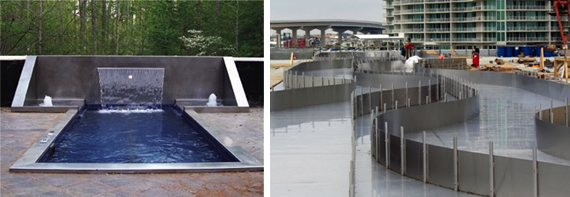|

Photos courtesy of Bradford Products
Welded stainless steel pool and spa linings provide long-term durability and are ideal for seismic regions, high-rise pools and other installations where movement is likely and leakage is unacceptable. Stainless steel linings are also an excellent choice for cost-effective retrofits and shape modifications because of the design flexibility possible. The ability to absorb energy without fracturing makes stainless steel ideal as a seismic structural retrofit material. Here are some pool liner resources:
Water Chloride Concentration
An often-overlooked cause of pool material deterioration or corrosion in standard non-saltwater pools is high chloride levels in the water. This usually occurs when one or more of the following conditions are present:
- Coastal or arid regions with naturally high chloride levels in the water;
- Deliberate chloride additions to create a “saltwater” pool;
- Outdoor water features and pools in sunny climates with low rainfall and high evaporation rates; and
- Chemicals sometimes used to prevent tile grout deterioration.
Ideally, chlorides (any ingredient containing “chlor” in its name such as calcium chloride or hydrochloric acid), other than those used for sanitation, should not be added to pool water as they can dramatically increase chloride levels if there is no adequate water replacement. Some localities have potable water chloride levels of up to 500 ppm. Information on chloride levels should be obtained from the water authority when design decisions are being made and considered when developing pool maintenance procedures.
Chloride levels can be easily checked with paper test strips. Type 304L should not be exposed to chloride levels above 250 ppm. As noted above, some potable waters are naturally above that level. If Type 316L stainless steel is used for the lining, gutters and water handling system, then the maximum chloride level can be as much as 500 ppm.
Saltwater Pools
Saltwater pools are growing in popularity, particularly for the elderly, those with sensitive skin and in community centers. Common stainless steels like Types 304L and 316L (and less corrosion resistant metals such as galvanized steel, aluminum and common copper alloys) should never be used for saltwater pool linings, ladders or water handling equipment because they will corrode rapidly.
Some stainless steels, such as the 6% molybdenum austenitics and super duplexes, are capable of withstanding saltwater pool conditions. They were developed for and are regularly used in industrial saltwater applications. These alloys are more expensive and require fabricators with specialized experience to manufacture ladders, railings and other components. The most cost-effective long-term approach for the pool body is to use concrete with stainless steel reinforcement. Less corrosion resistant reinforcement will fail. |